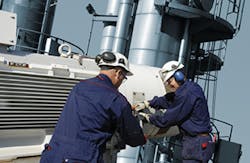Part II: How to Mate the Best Pump into a System
Larry Bachus
(“The Pump Guy”)
Editor’s Note: This is Part II in a two-part series on best practices for specifying pumps into a pipe system.
READ ALSO: Part I: How to Mate the Best Pump Into a System
In Part I of this article, I talked about how to specify a new pump into a pipe system, and how to calm down a problematic pump. It is easy to do if you can master a few concepts. When the pump, the liquid and the pipe system are correctly mated, most process pumps give many years of trouble-free service. You will get the projected life from your seals, bearings, lubricants, couplings and other components.
Reliable pumps with minimal maintenance don’t just happen because you bought a particular brand of mechanical seal, or applied a proprietary synthetic lubricant to your bearings. Reliable pumps are a joint effort between Design, Operation and Maintenance.
Some pumps fail prematurely because of incorrect maintenance practices. But strangely, most premature pump, seal and bearing failures result from incorrect pump operation, or deficient design. Let me explain.
A few years ago, labor was cheap. Energy was cheap, and raw materials were abundant. No one worried about pollution, the environment, or depleted resources.
Companies could grow by hiring more people, working them three shifts a day, plus Saturday and Sunday, while converting more raw materials into finished product. Company presidents wanted to know, "Are we making more money?"
In the process industries, no one really cared about the life of a mechanical seal, or a set of bearings, or the pump, or motor. Maintenance managers became saviors, leaders and climbed the corporate ladder if they could rebuild the pumps faster than the pumps failed.
Then the world changed. Energy, resources and labor were no longer cheap. Someone said, "Work efficiently, not faster." "Work smart, not hard."
Corporate accountants and engineering VPs went to seminars and learned about "Just in Time," "Zero Defects," "Total Quality," "Business Units," "Life Cycle Costs," "Conservation of Resources," "Return on Investment," "Reliability," and "Mean Time Between Failure (MTBF)."
The folly of "Rebuilding pumps faster than they can fail" was exposed. Attention was focused onto pump maintenance, labor, time and costs, particularly seals, bearings, and other spare parts.
The mechanics were trained in critical measurements, proper pump rebuilding techniques, proper mechanical seal installation, proper bearing installation, shaft alignment, and dynamic balance.
Companies developed Action Teams, Quality Teams, Reliability Divisions, Lubrication programs, Condition Monitoring, Vibration Analysis, Failure Analysis and computerized stock and inventory control. Now, most pumps are correctly assembled and repaired. Most mechanical seals and bearings are correctly applied, handled and installed.
MTBF on rotating equipment has slowly climbed from an appalling low "days and weeks," to a matter of months. Most reliability departments report MTBF statistics of 20 to 35 months. This brings us to today.
About 85 percent of all mechanical seals still fail prematurely with an average running time of 12 to 30 months before they leak. Coincidentally, this average running time is directly linked to the plant-wide MTBF statistics. Most reliability departments have hit a plateau of one to three years on rotating equipment.
The same team of machinists and mechanics balance, install, rebuild and repair all the pumps — the behaving pumps and the problematic pumps. So is it correct to point the accusing finger at the maintenance staff for habitual pump failure?
Most plants are standardized on one or two brands of mechanical seals for the process pumps. The same seals are installed on the problematic pumps…and on the behaving pumps. So, is it correct to blame the seal quality or seal manufacturer for premature failure?
Most plants are standardized on one or two brands of roller bearings for rotating equipment. The same bearings are installed on the problematic pumps — and on the behaving pumps. So, is it correct to blame the bearing manufacturer for habitual failure?
Therefore, we must look into the mirror and ask, "What is the difference between a pump that runs 22 months before leaking, and a pump that operates 15 years before failure?" Why have we hit a 30-month ceiling on reliability? What can we do to break through this 30-month MTBF barrier on rotating equipment?
Well, if we have already addressed and corrected the Maintenance issues, shouldn’t we now look to Pump Operation and Pump/System Design to take us to new heights of reliability?
Continued on next page



